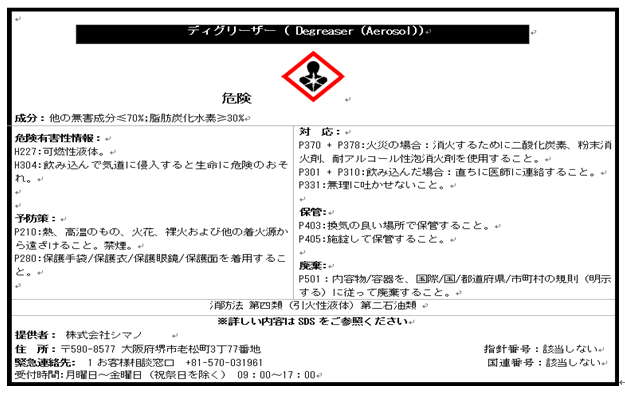You are here:Home >
JapanJapan
The newest standard of labelling is JIS 7253:2012 which is based on the V. 4 GHS in Japan.
Language: Japanese
The necessary information of making labelling (http://kikakurui.com/z7/Z7253-2012-01.html , Page 6)
1. Pictogram:
Adopting the normative pictogram used in GHS and the size is ≥ 1cm ².
Pay attention to following points of the pictogram:
(a) if the skull and crossbones  applies, the exclamation mark
applies, the exclamation mark5%7BYJM.png) should not appear;
should not appear;
(b) if the corrosive symbol applies, the exclamation mark
applies, the exclamation mark 5%7BYJM.png) should not appear where it is used for skin or eye irritation;
should not appear where it is used for skin or eye irritation;
(c) if the health hazard symbol appearsXWSVL4NZ%7D%7DT.png) for respiratory sensitisation, the exclamation mark
for respiratory sensitisation, the exclamation mark5%7BYJM.png) should not appear where it is used for skin sensitisation or for skin or eye irritation.
should not appear where it is used for skin sensitisation or for skin or eye irritation.
2. Signal word
The signal words of GHS are “Warning” and “Danger”. Each hazard class have a corresponding signal word. Please see JIS 7253:2012 annex A.
If the signal word “Danger” applies, the signal word “Warning” should not appear.
3. Hazardous information
Hazardous information is the hazardous categories and classes on the SDS. Mark the dangerous nature and degree of the chemicals. The hazard class is corresponding to hazard information. According to the class of GHS, JIS 7253:2012 annex A is corresponding to hazard information JIS 7253:2012 annex B.
The hazard information on the label can be showed by priority.
For example, if the statement H314 “Causes severe skin burns and eye damage” is assigned, the statement H318 “Causes serious eye damage” may be omitted.
4. Prevention, response, storage, disposal
In order to reduce the accident causing by improper store and disposal of the chemicals, each hazard class is corresponding to one or more different codes. And each code has a corresponding prevention, response, storage and disposal statement. (See JIS 7253:2012 annex C)
5. Names and relevant information of the chemicals
Names and relevant information of the chemicals should keep the same with SDS. If the content of the product is not classified into the noxious substance, it can use some alternative names to protect the suppliers’ business secret.
6. Relevant information of the suppliers
Supply the name, address, telephone, fax number, e-mail and emergency contact number (contact person) of the supplier.
7. Other items refer to Japan laws and regulations
If the supplier refers to Japan laws and regulations, such as fire protection laws, toxic and noxious substance control act and etc., it must be showed if it is applicable.
A label made by our company for reference:
